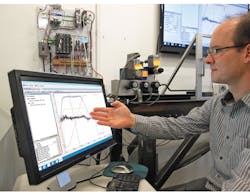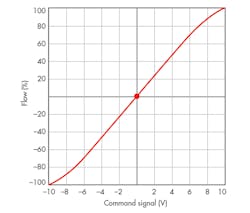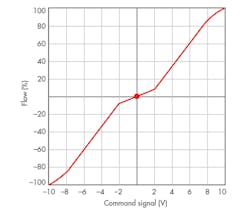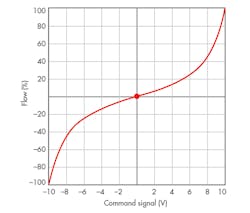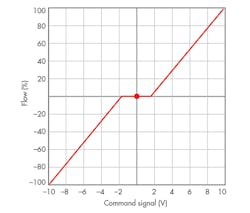This file type includes high-resolution graphics and schematics when applicable.
High-performance hydraulic valves are the workhorses of hydraulic motion control. Using the proper valves can make the difference between a great-performing, low-maintenance machine and one that causes defects in production parts and needs plenty of attention.
Presented here is a basic guide to selecting and applying these valves to help make your hydraulic motion system trouble-free. This guide is oriented toward readily available, servo-quality, 4-way valves to control a hydraulic cylinder with a motion controller that outputs a ±10-V command signal.
Cylinder motion control typically involves 4-way valves. There are two main types—there is no industry consensus on the exact terms, but the following classifications seem to cover it:
• Servo-quality proportional directional valves are the most common type, employing a linear motor, powerful solenoids, or voice-coil setup to actuate the spool. These generally need no adjustment.
• Current-driven servovalves, the “original” servovalves, contain either a jet pipe or flapper nozzle and are driven by electrical current, typically ranging from ±10 mA to ±200 mA. These valves require periodic readjustment of null, or center position.
Most recent developments in industry apply to servo-quality proportional valves. These generally have higher performance than traditional servovalves, which are usually more compact.
Linear Valves
The algorithms employed by motion controllers generally assume linear response of the system, meaning that sending 2 V to the valve will result in a velocity twice that of sending 1 V. To achieve good control, the valve’s flow versus command signal profile should be linear (Fig. 1).
Terms such as “kink," "knee," and "progressive" indicate a nonlinear valve. Nonlinear valves can certainly be used, but they require more setup in the motion controller, which must use a linearization algorithm to compensate for the nonlinearity. Traditionally, nonlinear valves (such as those represented in Figs. 2 and 3) are good for providing high maximum velocity while also providing fine control at low speeds. However, modern linear valves perform so well that there is rarely a need for nonlinear valves. Occasionally—when high velocity and exceptionally fine position or force control is required—a nonlinear valve may be preferable. Exercise caution, though, because if the nonlinear valve does not have great performance around the zero input point, it negates this advantage.
Zero-, Over-, and Under-lapped Spools
Zero-lapped means the spool is cut so that as soon as a voltage is applied to the valve, hydraulic fluid starts flowing. This is critical for dynamic systems that need to quickly change direction. An over-lapped spool (Fig. 4) means the spool must travel some distance before fluid starts flowing, which results in a zero fluid output for a certain amount of time. Reversing motion without delay is impossible with an over-lapped spool.
In certain cases, especially for pressure control, an under-lapped spool is desirable. An under-lapped spool is cut such that, at the center position, a slight flow issues from the pressure input port to the A and B output ports, and from the A and B ports to the tank port. This valve design provides a smoother transition in the system response when going from closed to open.
On-board Electronics
Valves with on-board electronics don’t need a separate amplifier card. Typically, with a good valve, you don’t need to adjust the on-board electronics. For motion control, spool position feedback is a must—the on-board electronics use this feedback to provide flow exactly as commanded.
I have found at least one case, involving a Yuken valve, where off-board electronics is required to achieve the very highest performance of the valve (allowing a higher-voltage supply). However, the on-board version performs very well, too.
Lower-Performing Valves
Valve manufacturers offer varying levels of performance. For example, the Bosch 4WREE is less expensive and slower than the Bosch 4WRPEH. As indicated in the valve datasheets, the less expensive valve has smaller solenoids, lower bandwidth, slower step response, and a nonlinear flow versus command signal profile, all of which make control difficult.
Also, these less-expensive valves are usually flow-limited at higher pressure drops between lands; that is, between the pressure port and the A or B port, and between the A or B port and the tank port. This is because the Bernoulli forces within the valve become stronger than the solenoid force and the valve begins to close, which wreaks havoc on the control loop. This has bitten a lot of people and is counterintuitive. So, unless you are aware of this phenomenon, it can cause confusion and frustration.
The Tradeoff Headache
If you enjoy headaches, choose a lower-performing valve with an over-lapped spool (creating a deadband in valve response) and a nonlinear flow versus command signal profile. The Bernoulli forces in cheaper valves also cause problems, though.
However, overcoming those problems can result in cost savings, particularly for OEM applications. In such applications—when you just need to go through the difficult setup and tuning process once and crank out your product in large volume—it can be well worth it to get a valve that is barely good enough to do the job. Conversely, on low-volume or one-off applications, the time-savings tradeoff in setup and maintenance usually justifies using a better-quality valve.
On-board Motion Control
Several manufacturers now include a motion controller in the valves’ electronics. This has some advantages in reduced wiring, but limits multi-axis synchronization. It also reduces flexibility and ease of maintenance in case of valve failure. If the valve fails, so does the motion controller.
Basic valves with a ±10-V input and no on-board motion control are less expensive, need no programming, and can often be directly replaced by another brand. This feature is useful in a machine-down situation, where you need to get up and running quickly but your original supplier has unacceptable lead times.
State of the Art
Precise comparison between valves is difficult because manufacturers list specifications for their valves slightly differently. However, for most hydraulic motion applications that require dynamic motion (quick turnarounds) and positioning of 0.001 in. or less, a “very good” D03 or D05 valve has a 3-dB frequency response (for 5% stroke) of 100 Hz or more and a step response of 10 ms or less.
Newer valves deliver ever-increasing performance. The latest D03 valves rated for flows of about 40 to 60 lpm achieve step-response times of down to 5 ms and 3-dB frequency response of up to 400 Hz. D05 valves capable of about 100 lpm are only slightly slower.
Delta Computer has tested many valves from various manufacturers, so we can confidently provide recommendations to our customers. We have the most information on the more common D03 and D05 (NG6 and NG10) servo-quality proportional valves. Performance data on larger valves comes from our customers and spec sheets. If any valves are missing from the following list, we welcome the manufacturer to send us an example so that we can test it, and subsequently provide any recommendations.
Atos SpA—Two valves, the DLHZO-TEB and DLKZOR-TEB, are single-stage in sizes NG6 and 10. The L in the part numbers indicates a sleeve, which provides more precise control and faster response.
The DPZO-LEB is a two-stage valve in sizes NG10 to 35. The EB indicates the basic integral digital driver, which is all that’s needed when using Delta’s RMC motion controller to control the valve with a ±10-V signal. Therefore, do not choose any P/Q controls or fieldbus interfaces, which only apply to the full integral driver. Instead, opt for the linear spool for most applications.
I have found the progressive-spool ATOS valves to be particularly well-behaved around zero, making them great candidates for the few cases when you want a progressive spool.
Bosch Rexroth—The 4WRREH valve comes only in size NG6. It has fast response, with a step response of less than or equal to 5 ms. The 4WRPEH comes in sizes NG6 and NG10. The NG6 is not as fast as the 4WRREH, but, nonetheless, plenty good. Again, be sure to choose the ±10-V command option.
Rexroth’s 4WRVE comes in sizes 10 to 35. I haven’t tried this one, but the specs indicate it is a higher-performance version of the 4WRLE, which has been a solid performer for years. Be sure to choose the V indication (indicating a lapped spool) with the L (linear) flow characteristic.
The 4WRLE also comes in sizes 10 to 35. The V spool with the L flow characteristic should be chosen in this case, too.
Eaton— Axis Pro valves offer high response and are available in D03 and D05 versions: the KBS-03 and KBS-05, respectively. Choose level 1 in order to work with Delta’s RMC motion controller
Moog— The D661 has very fast response and high flow, as do the D681 to D685. All are available in ISO 4401 sizes 05 to 10. Moog’s D633/634 and D636/637 also produce good test results.
Moog’s 79 series valves have extremely high response at 200 gpm (750 lpm)—the fastest response I have ever seen at such a high flow.
Parker Hannifin—The DFPlus voice-coil valves are great-performing valves with very high response. The D1FP and D3FP are sizes NG6 and NG10, respectively. The D1FH is not as high performance as the D1FP, but also works quite well.
ALA Industries (Yuken Kogyo)—Yuken’s LSVG-01-EH and the LSVG-03-EH have very high response and linear output with on-board electronics, but the D03 and D05 sizes max out at 60 lpm. Yuken also makes a similar high-response D05 valve, the SE1024, with higher flow capability: 130 L/min. Yuken provides even faster response with off-board electronics, which allows a higher-voltage power supply.
Conclusion
Designing a hydraulic motion-control system to meet the objectives of your application involves many considerations. Selecting the proper valve is essential, and hopefully the tips listed here will help bring you one step closer to a smooth experience.
Other important factors include choosing the proper position, pressure, or force sensors; placing the valve close to the cylinder so the motion controller controls only the cylinder (not the compression of oil or expansion of hose); and selecting a motion controller designed for hydraulic motion.
Jacob Paso is Motion Product Development Manager at Delta Computer Systems Inc. For more information, visit deltamotion.com or call (360) 254-8688.


